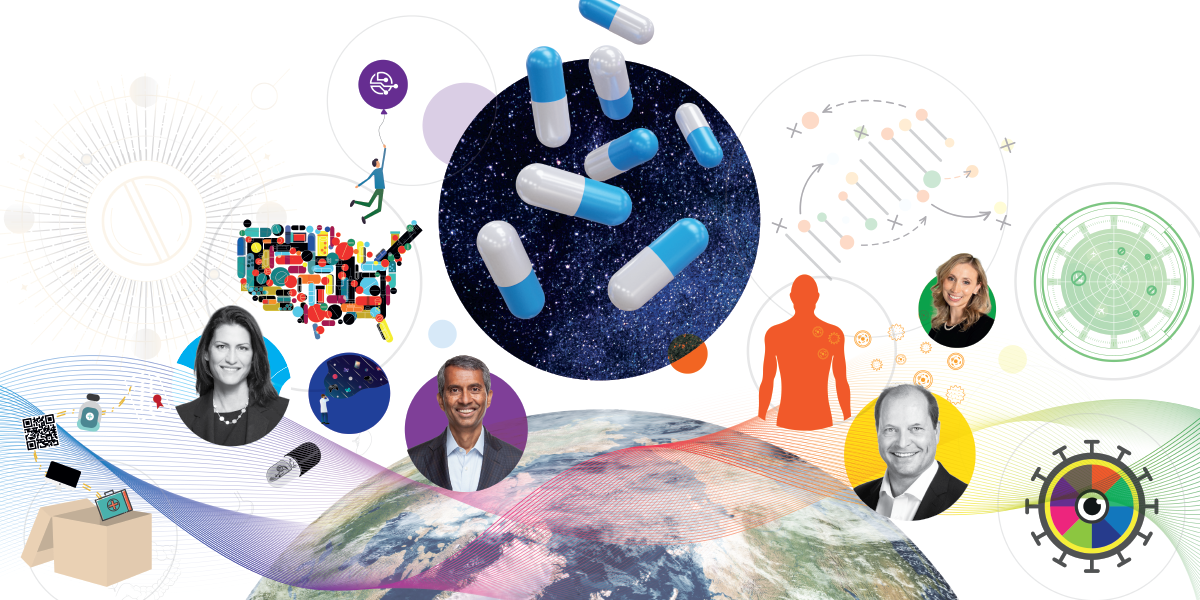The Multifaceted Future of Pharma – Chapter 4: Therapeutic Areas to Watch
GLP-1s, mRNA, and Alzheimer’s are key areas to watch in the pharma world.
Treatments for obesity are taking the drug development world by storm. Our experts point to GLP-1s as a key area to watch, alongside mRNA, digital therapeutics, Alzheimer’s, aging, and more.
We asked: What has/have been the key disruptor(s) driving the industry over the past ten years, and how will this change in the next 10 years?

“Rather than a one-size fits all approach to drug design and development, personalized therapies and treatment regimens tailored to the unique needs of patients have become a cornerstone of modern healthcare. A great example of this is the industry’s innovation in obesity. As a multifactorial disease, obesity has historically been a challenging condition to treat because of the complex interplay of genetic, behavioral, and environmental factors. However, the development of new therapies that mimic naturally occurring hormones in the body has revolutionized obesity management – improving patient outcomes and bringing a renewed focus on treating obesity as a chronic disease rather than a lifestyle issue.
“In the next 10 years, the obesity drug development landscape will continue to evolve as we place even greater emphasis on patient-centric approaches to develop therapies with enhanced tolerability and enable more precise targeting of obesity-related pathways, leading to treatments that are more effective for specific patient subgroups – addressing cardiovascular health, liver health, metabolic health, and more.
“I also expect we’ll see the integration of emerging tools and technologies, such as AI and wearable technologies, into clinical trials to enable accessible and equitable approaches to research and innovation. Integrating AI into clinical trials can drive enhanced efficiency from the patient selection and enrollment process to more robust measurement of clinical endpoints. In preserving invaluable time and resources, while bolstering non-invasive measurement capabilities, these improvements stand to reduce the costs associated with traditional drug development. We can also leverage new technologies to implement decentralized clinical trials. Such trials would allow us to reach a broader, more diverse range of patients including those who may have been previously undertreated and understudied because of limited access to healthcare and research trials.”

“GLP-1 drugs – like Ozempic, Wegovy, Mounjaro, and Zepbound – have taken the world by storm. They address a significant unmet medical need with proven, almost universal effectiveness, which has created a blockbuster scenario. However, many patients still cannot access these drugs or choose not to use them due to factors such as cost, availability, or a dislike of needles. There is growing interest in making these drugs more accessible, and one potential solution is developing them in pill form.
“Novo Nordisk already offers a low-dose oral GLP-1, which has shown promising results in late-stage trials for a higher-dose oral version. While smaller than traditional biologics, they share similar bioavailability challenges. Ensuring a reliable supply chain will also be crucial to meet patient demand. This must be managed to keep costs affordable for both payers and patients while allowing manufacturers to protect their margins and recoup their investments.
“Early estimates suggest that oral GLP-1s could be priced 25 percent lower than injectables if they reach the market. Over the next decade, if the pharmaceutical industry succeeds in developing non-injectable biologics, it could lead to a significant transformation, providing broader access and lower costs for patients.”
“When it comes to disruptors, all current indicators suggest GLP-1 and hormone-derived peptide drugs will make a big difference. People call it the healthcare revolution, and I tend to agree. These drugs represent the beginning of a blur between lifestyle, nutrition, healthy living, and medicine.
“When you lose weight, you feel better about yourself – and naturally, everyone will want that choice for themselves (irrespective of doctors and healthcare systems). The industry must now get ready for that possibility. With lifestyle, it is more important than ever that you can scale manufacturing effectively, fast, and produce quality at low cost.
“We mustn’t avoid the reality of sustainability in this conversation, however. If for every injection there is roughly two liters of DMF that goes down the drain, consumers won’t feel good about the product. These are great molecules, and our part is to make them safe, affordable, and environmentally friendly.”

“Immunotherapy has already changed cancer treatment drastically over the last 10 years. In particular, immune checkpoint inhibitors (which remove the breaks from T cells) now provide effective options for difficult-to-treat cancers with reduced side effects when compared to chemotherapy. There are, however, numerous challenges to address, such as the indications where checkpoint inhibitors have limited effects.
“In the next ten years, advancements in personalized medicine will likely be driven by AI-supported development of new immunotherapies, biomarker discovery, and the integration of multiomic methods into clinical practice. These innovations aim to deliver more effective and safer treatments, improving patient outcomes and increasing the success rate for biopharma companies.
“The future of cancer treatment also lies in combination therapies that exploit the synergy between immunotherapy and other treatment methods, such as chemotherapy, radiation, and targeted therapies. Various combinations of approved and experimental treatments are being evaluated for their effectiveness. However, combination therapies also come with an increased risk of side effects, making it essential to develop immunotherapies with strong safety profiles. Achieving this will depend on optimizing dosing schedules when combining new immunotherapies with standard care, as recent progress has shown that proper dosing can significantly influence the success of these treatments.
“Further development of immunotherapies targeting innate immune cells will be crucial in complementing existing checkpoint inhibitors, which rely on a pre-existing tumor-specific T cell response. Current efforts to target myeloid cells aim to either deplete or inhibit immune-suppressive myeloid cells or to reprogram them. One approach uses CD40 agonists, which have shown the potential to overcome resistance to checkpoint inhibitors, increasing response rates in cancers where these inhibitors are already approved. Additionally, CD40 agonists have demonstrated synergy with chemotherapy in tumors resistant to checkpoint inhibitors, such as pancreatic cancer.
“In the near future, cancer treatment could change significantly, with immunotherapy providing options where conventional therapies fail. This is especially relevant for cancers like pancreatic cancer, which are often diagnosed at a late stage with a very poor prognosis. Today, such a diagnosis is often seen as a death sentence, but continued advancements in immunotherapy could offer these patients a chance for better outcomes.”
“We have witnessed significant innovation across multiple therapeutic modalities, especially RNA. The urgency that COVID-19 introduced allowed for the investment and talent needed not only to develop the vaccines, but also to provide a foundation for future development. Given the numerous kinds of RNA currently under development, it will be exciting to see how the space evolves beyond the initial applications in infectious disease, and into indications such as cancer and rare diseases. In addition, addressing key hurdles around RNA delivery and durability will be essential to unlocking the full potential of RNA therapies. This ongoing work seeks to address cell- and organ-specific delivery both with and without the use of lipid nanoparticles.
“Patient safety remains of the utmost importance, and a better understanding of RNA and its delivery systems, as well as how it interacts with other molecules, will help us assuage any safety considerations. As more RNA-based therapeutics advance through development, it will also be interesting to see how the regulatory processes evolve alongside. Ultimately, there’s no doubt that the next 10 years will be an exciting time for the RNA space and will hopefully allow for the development of therapies that address significant unmet medical needs.”

“We, as an industry, have long been trying to address the scourge of Alzheimer’s disease – a silent pandemic with a staggering unmet medical need and unsustainable costs for society and medical systems. With that perspective, the progress made in the last several years has been both impressive and exciting. After decades of research, we now have approved disease-modifying treatments and, for the first time, have been able to slow the neurodegeneration. Very welcome news for patients and their families.
“Even more importantly, we should be viewing this success as a starting point. Just as with cancer, research will now advance swiftly and there will be an acceleration in developing effective treatments, and strategies for prevention, over the next decade.
“Neuroscientists agree that a precision prevention approach is needed to address this complex disease. The first signs of cognitive decline appear after the disease has been present for several years. By then, many neurons have died and cannot be replaced.
“New diagnostic tools will be developed to allow us to detect the disease long before symptoms emerge and preventive strategies will be developed and rolled out. This then opens the future possibility of both halting progression of Alzheimer’s and perhaps even preventing it from developing in the first place. Now that would be truly revolutionary.
“To achieve this, I believe we need active immunotherapies, which are a type of vaccination approach, as well as combination treatments. Active immunotherapies could potentially be used much earlier in the progression of disease – even before symptoms develop – because they offer improved safety and convenience for patients and potentially lower cost, and there are several already moving through clinical development. With early signs of immune activation and good safety profiles there is good cause for optimism that the first active immunotherapies could reach the market by 2030.
“We used to think HIV was untreatable. Many cancers were once effectively a death sentence. Just look at how science has transformed how we view those diseases. In just a few years, Alzheimer’s could be something we can live with, while still being able to do many of the things we love. And we could even dare to dream that we could prevent this devastating disease completely.”
“Over the past decade, scientific breakthroughs in the biological underpinnings of aging have led to the emergence of an entirely new area of drug development – cellular rejuvenation. We now know that aging is not just a result of random wear and tear on our bodies, but is controlled by discrete biological mechanisms. This knowledge allows us to develop therapeutics targeting these key drivers to treat age-related diseases. For instance, it’s now understood that the epigenome drifts with age, leading to dysregulated gene expression. With this insight, we can develop therapeutics that partially reprogram the epigenome of aged and injured cells, reverting them to a more youthful state – the aim of cellular rejuvenation.
“In the next ten years, these advancements will enable us to treat and potentially reverse age-related diseases rather than merely managing their symptoms. Addressing the root causes of diseases could enhance healthspan, the number of healthy years lived. For example, new approaches are being developed to address conditions like non-arteritic anterior ischemic optic neuropathy, a rare eye disease with no approved treatments, and glaucoma, a leading cause of blindness, through cellular rejuvenation. Looking even further ahead, the potential of cellular rejuvenation could extend to a broader range of age-related diseases, fundamentally changing the landscape of medicine and human health.”

“Biopharmaceutical companies have long been in pursuit, yet have consistently fallen short, of delivering a treatment for patients with metabolic dysfunction-associated steatohepatitis (MASH), a chronic and progressive liver disease that is a leading cause of liver transplants among adults. The accumulation of fat and inflammation in the liver caused by MASH can result in fibrosis, which damages the liver and leads to more severe liver-related complications, including cirrhosis, liver failure, and hepatocellular cancer (HCC).
“Once a patient develops cirrhosis, the risk for serious intervention such as liver transplant increases. In the past 10 years, the industry has been actively trying to change the trajectory of this disease. In 2024, the FDA approved the first treatment for MASH, but there is still a need for additional therapies to treat millions of patients worldwide.
“It comes as no surprise that weight-loss therapies such as glucagon-like peptide-1 (GLP-1) agonists have disrupted the treatment landscape for patients with obesity, type 2 diabetes, cardiometabolic diseases, and a growing number of indications in the past couple years. However, these GLP-1 options have not demonstrated rapid anti-fibrotic effects that advanced MASH patients need to improve outcomes, alleviate the burden of this disease and make a huge impact on the healthcare system. In the next 10 years, I anticipate there being more potent and more tolerable anti-fibrotic therapeutic options for MASH available to address this white space for patients.”

“Prescription digital therapeutics (PDTs) have been a key disruptor driving the industry over the past ten years and will continue revolutionizing the healthcare landscape, particularly for mental health. One billion individuals worldwide currently live with a mental illness, many of whom often experience stigma, inaccessible care, provider shortages, and healthcare systems that are difficult to navigate. These barriers contribute to delayed diagnoses and less effective ongoing management and long-term support. PDTs have the potential to provide meaningful benefits to both providers and patients managing serious mental illnesses. Providers can deliver direct care through remote, customizable plans, while patients can access treatment regardless of time or place. This makes healthcare more accessible, affordable, and more easily adaptable, which is vital for individuals with serious mental illnesses that make it difficult to coordinate in-person visits and stay on top of their treatment plans. As technology evolves, so must our approach to care. At Boehringer Ingelheim, we’re excited to see how PDTs will evolve to address unmet patient needs and make healthcare more accessible.”
“A key disruptor driving the industry over the past ten years has been mRNA technology, which was validated and accelerated by the COVID-19 pandemic. This groundbreaking technology enabled the rapid development and deployment of effective vaccines at the height of a global crisis, highlighting its immense potential in infectious diseases and beyond.
“In the next decade, mRNA technology is poised to revolutionize many areas of medicine. Its flexibility and efficiency in addressing multiple biological targets at the same time opens doors to novel treatments for a wide range of conditions, including cancer, genetic disorders, and rare diseases. The ability to personalize therapies by quickly designing and producing mRNA sequences tailored to specific medical needs could drive personalized medicine, offering patients more targeted and effective therapies.
Moreover, advancements in delivery systems and mRNA stability are expected to further enhance the efficacy and applicability of mRNA-based treatments. As research continues, we anticipate a surge in innovative applications, transforming not just the pharmaceutical industry but also the broader healthcare landscape.
“In summary, the validation of mRNA technology during the COVID-19 pandemic marks just the beginning of its transformative potential, setting the stage for significant advancements and new frontiers in medical science over the next decade.”
“The large number of autoimmune diseases poses a vast – and largely unsolved – problem for human health. They attack many parts of the body, often with serious, and sometimes lethal, consequences for patients. In some cases, healthy lifestyle choices can prevent or delay onset, but generally there is only a narrow choice of disease-modifying treatments for these chronic diseases.
“I believe that the coming decade bears the promise of a solution for many of these ailments, in the form of cellular therapies, and that we are on the threshold of a breakthrough in the development of autoimmune disease therapies. The T-regulatory cells that I have studied all my life, and developed as therapies, have proven that – for the first time – we may be able to treat many of these diseases, or even prevent them.
“Treg cells function as the police force of the immune system. Unlike traditional drugs, they have the advantage of being active only on the site of inflammation, and of switching off as soon as the problem is over. The cells can be harvested from a patient, expanded ex vivo, “and administered back into the patient’s bloodstream. This requires an extremely technologically sophisticated manufacturing process, but it can be mastered.
“The work we have done with type 1 diabetes patients in Poland is part of the reason I’m confident that we’re on the brink of a breakthrough in fighting autoimmune diseases in the coming decade. For the first time, we could have a medicine that can suppress symptoms of type 1 diabetes altogether, freeing patients from the need to inject insulin, and, most importantly, from the serious complications of the disease. And I see this as only the first small steps of an industry-wide breakthrough in treating autoimmune diseases in the coming decade.”
“For decades, we have understood how to train the human immune system to attack specific pathogens through vaccines, but creating antigen-specific immune tolerance has proved more complex.
“Our strategies for treating autoimmune disease largely rely on a few categories of medicine including several notable blockbuster treatments. These catch-all approaches largely rely on general immune suppression and fail to address the root cause underlying many autoimmune diseases. Consequently, current treatments are incredibly burdensome to patients and often fail to prevent disease progression.
“While our tools have remained largely the same over the past decade, our understanding of the mechanisms underlying immune tolerance and the specific antigens the body has failed to recognize as self has grown tremendously.
“With the advent of new delivery technologies, we have an incredible opportunity to transform the way we treat autoimmune diseases. Instead of broad immunosuppression, we could potentially elicit antigen-specific immune tolerance to halt or even reverse disease progression.
“There are multiple emerging approaches, rooted in novel delivery technologies designed to present specific antigens to the immune system in the appropriate physiological context to induce immune tolerance. More than just a treatment for a single autoimmune disease, these platforms are modular and would only require a change in antigen to be applied to another indication.
“If successful, these new treatment strategies would transform the lives of patients living with autoimmune disease, by liberating them from the burden of constant immunosuppression. Moreover, the potential to create disease modifying therapies for indications where none had previously existed would lead to an influx of investment and propel the entire field forward.”

“In the next ten years, I think we’ll see a greater emphasis on regenerative medicine approaches, including disease specific interventions and disease agnostic approaches that can be applied across many conditions. Regenerative therapies, rather than merely managing symptoms or slowing progression, have the potential to actually improve function and quality of life. This will be particularly important for neurodegenerative diseases where many current treatments focus on management of symptoms or interventions that, for diseases like ALS and many others, offer only modest benefit in terms of disease progression and life span.
“We are starting to see more interest in regenerative therapies that aim to reverse disease pathology by, for example, regenerating synapses across a broad spectrum of neurodegenerative diseases to restore lost functions and make a meaningful impact for patients. Ideally, the next 10 years may see a convergence of regenerative therapies with precision medicine approaches that target specific pathogenic processes, yielding synergies that improve outcomes much more than is possible today. We may also see many new regenerative and other approaches that mitigate the aging component of risk for many diseases.
“Additionally, ensuring that drugs in development are accessible to those who need them should be a priority. This requires manufacturing and production processes to be patient-centric, focusing on creating accessible treatments, such as oral pills versus injections. These can enhance patient compliance, reduce healthcare costs, and improve overall outcomes.”

“To make life-changing therapies available to patients more quickly and affordably, the industry needs to prioritize development and approval pathways that expedite patient access. For instance, new branded drugs are often too expensive until generics are available years later, forcing many patients to use less effective therapies or those with unwanted side effects. The FDA’s accelerated 505(b)(2) approval pathway is one route that I hope can be employed more often by developers to bring new drugs to market by referencing data from products that have already been approved, often enabling them to shorten or even forgo large efficacy studies. This can help reduce approval times, increase available options, and lower drug prices.
“I would also like to see a greater emphasis on accessibility in the selection of novel drug candidates for development. In the mental health treatment space, psychedelic therapies have shown tremendous potential for addressing anxiety, depression, PTSD, and more, yet the associated multi-hour “trip” necessitates administration under medical supervision. Novel psychedelic compounds designed without the “trip” component could potentially deliver the same therapeutic benefits in an at-home, unmonitored treatment setting, drastically decreasing the cost of delivering these medicines. By directing innovation and development resources towards efforts that prioritize patient-friendly, accessible, and affordable therapies, we can help connect patients with potentially life-changing treatments sooner.”